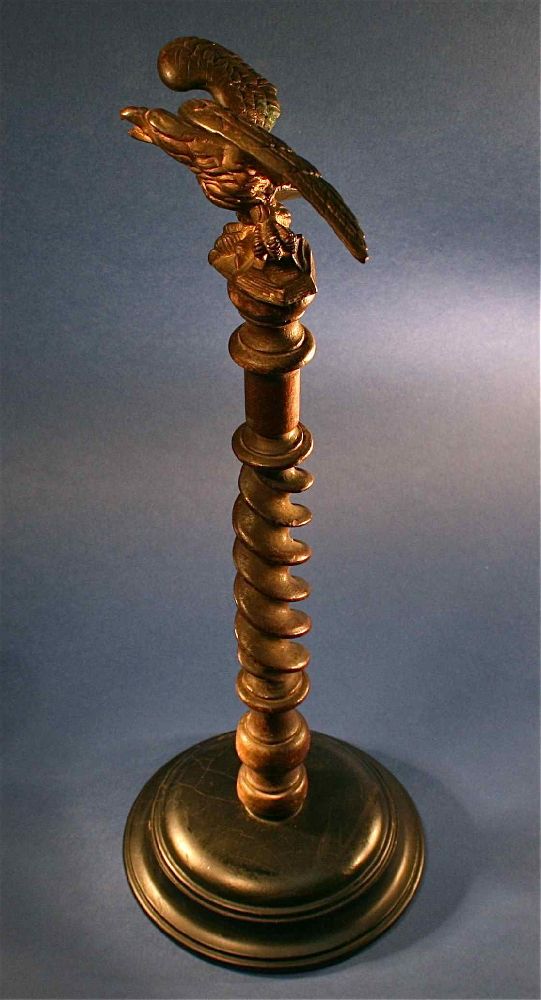

Title: Bronze & Wood Pole Stand Antique Bird Eagle Finial Sculpture
Shipping: $65.00
Artist: N/A
Period: Unassigned
History: N/A
Origin: North America > United States
Condition: Museum Quality
Item Date: 1880 to 1930
Item ID: 5311
This is a great old finial on a handcarved pole. Fantastic quality large early gilded bronze American eagle finial. It looks to be some kind of Flag pole design. This is at least 100 years or more. Dates to the 19th Century. The first symbolic representation of the hawk/eagle is that of national pride depicted in the coat of arms especially in the United States, but also in a number of countries, cultures, and religions. The US seal was first used publicly in 1782. The eagle is used in heraldry as a charge and as a crest either on a flag or a banner suspended in space and out of its natural environment. Parts of the eagle’s body such as its head, wings or legs are also used as a charge or crest in a serious manner. This makes sense since the eagle is seen as masculine strength and courage and is considered to be the king of the air and the messenger of the highest Gods. With broad, outstretched wings clutching 13 arrows in one talon and an olive branch in the other, he has remained a symbol of war and of peace for centuries.
Link: http://en.wikipedia.org/wiki/Finial
The United States Navy and Coast Guard are unique in that they employ a variety of different finials depending on the flag in question.
Many designs hark back to the gothic and neo-gothic of architectural finials, while other contemporary finials reflect minimalist, art nouveau and other traditional styles of décor. The use of different materials is as wide as the range of designs with brass, stainless steel, various woods and aluminium being employed with a variety of finishes such as ‘satin steel’ and 'antique brass'. The durability, strength and machinability of modern alloys have lent themselves to increasingly intricate and dazzling designs.
A "ball-style" finial is commonly mounted to the top of a stationary flagpole. This is sometimes incorrectly called a "truck", which is the mechanism that connects the finial to the pole. An urban legend says the ball contains a razor, lighter, and flare. According to the legend, the items were meant to be used to destroy the flag in case the post was overrun by the enemy. A related and less pleasant version says the finial should have a bullet, knife, and matches so the last surviving soldier can continue fighting (with the knife), and if need be destroy the flag with matches (to prevent it from being captured), and take his own life with the bullet. In actuality, the finial of a flagpole is generally inaccessible, and contains nothing.
The finial is an architectural device, typically carved in stone and employed decoratively to emphasize the apex of a gable or any of various distinctive ornaments at the top, end, or corner of a building or structure. Smaller finials can be used as a decorative ornament on the ends of curtain rods or applied to chairs and furniture. These are frequently seen on top of bed posts or clocks. Decorative finials are also commonly used to fasten lampshades, and as an ornamental element at the end of the handles of souvenir spoons. Architectural finials were once believed to act as a deterrent to witches on broomsticks attempting to land on one's roof. Finial is also a term given to straw animals at the ridges of thatched cottages. Finial maker is the term given to the artisan that makes the straw animal.
During the various dynasties in China, a finial was worn on the top of the hat's civil or military officials during formal court ceremonies. The finial was changed to a knob for other daily usage (including semi-formal ceremonies).